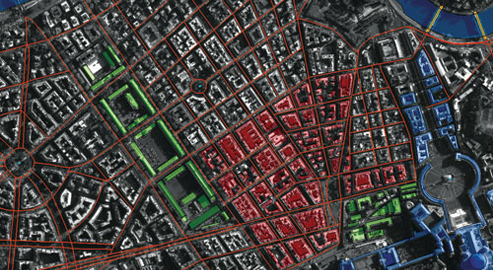Mobile Apps

SOCET for ArcGIS® combines the stereo photogrammetric capabilities of BAE Systems’ SOCET GXP® software with the cartographic and feature-editing tools of the Esri® ArcGIS® application.
The power of SOCET GXP inside an ArcMap® canvas
SOCET for ArcGIS is a SOCET GXP to Esri module that gives analysts the capability to collect 3-D feature data from a SOCET GXP Multiport while simultaneously updating the data inside the ArcMap® canvas. This allows the Esri community to use the rigorous sensor models and stereo imagery capabilities inside of SOCET GXP to collect, edit, and assign attributes to features while still maintaining access to tools within the ArcMap environment. SOCET for ArcGIS supports Esri personal, file, and multi-user geodatabase formats.
Key capabilities
- SOCET GXP processes imagery from an unequalled range of aerial and satellite sensors
- SOCET GXP manages image viewing including full stereoscopic functionality
- ArcMap Editor tools work in 3-D
- SOCET GXP 3-D feature collection and editing tools are available
- Automatic attribution based on image or system metadata
- Works with personal, file, or multi-user geodatabases
- Versioning and topology
- Imagery can be imported and triangulated on a SOCET GXP workstation, then distributed to a group of SOCET for ArcGIS workstations for low-cost feature collection and editing
- Requires SOCET GXP v4.1 or later on the Microsoft® Windows platform, and ArcMap 9.3 or later
Exploit imagery and collect features
Working with SOCET for ArcGIS allows users to benefit from SOCET GXP's core capability to exploit rigorous sensor models — it embeds the photogrammetry into ArcMap and controls versioning and topology. A key advantage of SOCET for ArcGIS is the capability to extract and update features from a wide range of satellite and airborne imagery. As new imagery is collected, map updates and edits can be compiled by loading the appropriate geodatabase and using either SOCET GXP drawing or ArcMap sketch tools to add, modify, or edit features.
As each feature is collected, basic attribute information can be tagged, assigned, and managed using ArcGIS feature attribute editing tools. SOCET GXP can also automatically attribute features based on image or system metadata which reduces the amount of manual information a user needs to populate. These attributes can be customized to update on feature edit or only on feature creation. The combined SOCET for ArcGIS and ArcMap toolkit makes it possible for analysts to work in a seamless photogrammetric and GIS environment to compile and maintain GEOINT geodatabases efficiently.
Embed and easily maintain photogrammetry in GIS
The use of photogrammetric methods to populate and update GIS databases has always been essential, but not easy. Typically, feature collection and editing is achieved by specialists using software designed for photogrammetrists. Features are moved to and from the GIS database by translators. This step adds inconvenience to the process, and increases the potential for loss of data and quality. SOCET for ArcGIS is an advanced, rigorous approach that alleviates these issues.
Most geographic information loses value rapidly unless it is up-to-date. Data can be maintained easily and cost-effectively using SOCET for ArcGIS. The SOCET for ArcGIS user does not need to be a photogrammetrist — the important thing is to understand the features needed for the project. A new database can be populated rapidly from imagery. Because features are superimposed on the imagery, it is easy to check or update an existing database.
SOCET for ArcGIS architecture – How to collect and edit features
To collect and edit features from imagery for populating and updating GIS databases, it is necessary to use a rigorous approach, with mathematically correct sensor models linked to the display and measurements in a window with stereoscopic viewing. This is accomplished through SOCET GXP, which includes formats and sensor models for an unequalled range of airborne and satellite imagery, plus end-to-end capabilities for orientation, triangulation, and image display.
The GIS user loads the imagery into a SOCET GXP stereoscopic window where precise positional movement of the cursor is linked to the ArcMap environment. Next, the user selects the familiar Editor tools in ArcMap, including 3-D tools. There also is an option to switch on SOCET GXP drawing tools, which include many functions for 3-D collection and editing.
For example, sketch functionality includes a tool for inputting attributes, and an automated option for attributes such as circular error (CE) and linear error (LE) estimates, as required by NGA and NATO specifications. The features, whether collected with ArcMap or SOCET GXP drawing tools, are directly written to a personal, file, or multi-user geodatabase. Because the user sees cursor movement in the stereo Multiport synchronized with cursor movement in the ArcMap environment and overlaid on top of the ArcMap canvas, the display is very simple and easy to learn and use. Sophisticated functionality such as versioning and topology takes place behind the scenes.
Efficient and cost effective
A powerful production line can be organized through the use of a single SOCET GXP workstation to manage projects, import imagery, and perform triangulation. Imagery that has been oriented can be distributed to a large group of economical SOCET for ArcGIS workstations for feature collection and editing. One photogrammetrist serves an entire team of GIS data collectors and editors.
Module information: SOCET GXP for ArcGIS
Product compatibility: SOCET GXP® as part of Spatially Enabled Exploitation module (1011).
Licensing requirements: eXtreme Analysis Bundle
Part number: SOCET GXP SEE (1011)